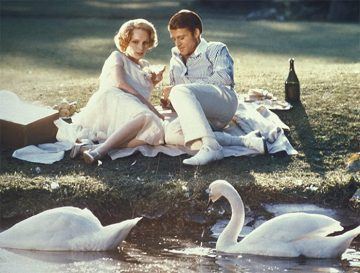Matt Hanson in The Baffler:
 IN A TELEGRAM SENT from the South of France in March of 1925 to the Scribner office in New York, F. Scott Fitzgerald shouted the new inspiration for his third novel from across the Atlantic: “CRAZY ABOUT TITLE UNDER THE RED WHITE AND BLUE STOP WHART WOULD DELAY BE.” Luckily, his publisher was either too busy printing The Great Gatsby to make any changes or was too tactful to tell the excitable author he had a dumb idea. The phrase works better as the title for a new study of the novel’s legacy by renowned cultural critic Greil Marcus. The Great Gatsby lives on almost a century after its anticlimactic publication, Marcus argues, because it works as both a symbol of and a critique of different aspects of the American Dream—patriotism, wealth, disenchantment, the pursuit of happiness.
IN A TELEGRAM SENT from the South of France in March of 1925 to the Scribner office in New York, F. Scott Fitzgerald shouted the new inspiration for his third novel from across the Atlantic: “CRAZY ABOUT TITLE UNDER THE RED WHITE AND BLUE STOP WHART WOULD DELAY BE.” Luckily, his publisher was either too busy printing The Great Gatsby to make any changes or was too tactful to tell the excitable author he had a dumb idea. The phrase works better as the title for a new study of the novel’s legacy by renowned cultural critic Greil Marcus. The Great Gatsby lives on almost a century after its anticlimactic publication, Marcus argues, because it works as both a symbol of and a critique of different aspects of the American Dream—patriotism, wealth, disenchantment, the pursuit of happiness.
In Under the Red White and Blue, Marcus dusts off a collection of cultural products and finds Gatsby’s fingerprints all over them. He finds traces of Gatsby (sometimes more convincingly than others) in songs by Lana Del Rey and Jelly Roll Morton; in novels by Chandler, Roth, and Ross Macdonald; in an epic stage play that features a live reading of the entire text; in one of Andy Kaufman’s standup routines; and, of course, in the book’s various film adaptations. Marcus gets more out of director Baz Luhrmann’s flashy 2013 version than it probably deserves—that one was the fourth attempt, not counting the 1926 silent movie version, and like the others it fell short of its potential. Gatsby is also invoked in the nicknames of Korean pop stars and in advertisements for swanky New York luxury hotels that offer “the full Gatsby experience,” blood-stained swimming pools not included.
More here.
